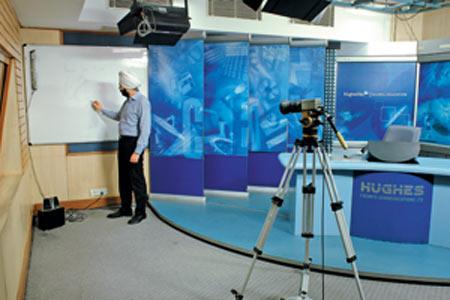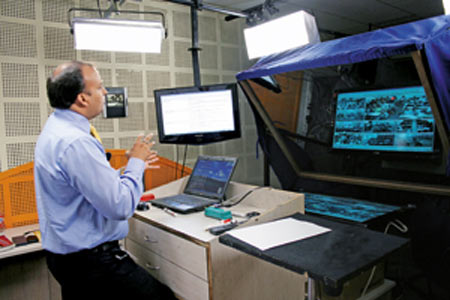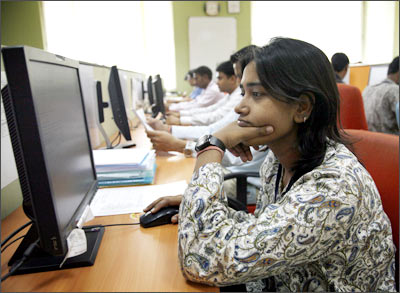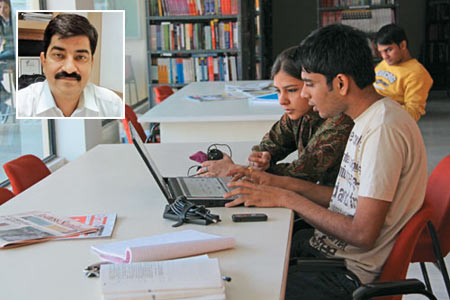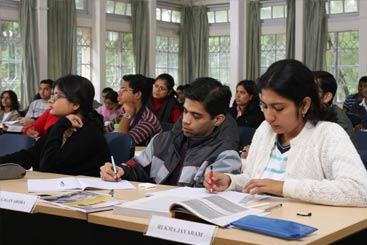 | « Back to article | Print this article |
Online education: Can technology replace classroom learning?
Distance learning is shedding its conventional garb of courier correspondence and moving on to high-tech avatar. Education is mobile, it follows you. Are you motivated enough to leverage technology for your academic excellence?
Mohanty tears himself away from the computer, taking off his headphone.
He is logged on to a virtual classroom at an educational nodal centre in Ranchi, the capital of Jharkhand. A resident of Jamshedpur, Mohanty is in the city on an official visit. And when the sales professional reports back to work on Monday, he will continue with his next class in Jamshedpur.
Education follows NP Mohanty, a PGDM student, and several other working professionals like him who are unable to enrol in regular colleges.
Earlier, correspondence courses were an answer to ambitious individuals like Mohanty. But they didn't offer access to several other privileges enjoyed by classroom enrollees. Lectures of handpicked faculty and online admissions, for instance. And much more.
Technology has been a game changer in distance learning education. But is it really shifting the goal posts?
Dr HC Pokhriyal, of the School of Open Learning (SOL), Delhi University maintains so. Technology in Distance Learning (DL) is a movement, he says. SOL saw enrolments peak at over two lakh students in the academic year 2006-07.
"In any given year, the admissions are not less than one lakh students," apprises Dr Pokhriyal, the executive director of the school that pioneered DL education.
Back in 2001-02, right at the fledgling stages of technology, enrolments in IGNOU, another DL provider giant, hovered at three lakhs in various programmes.
A rather new entrant, Welingkar had 15,000 enrolments last year for its 20 DL programmes. Sikkim Manipal boasts of two lakh students. A large number of enrolments are encouraging. Not only because they signal individuals' increased leaning towards DL but also because they indicate institutions' participation in the national goal, the objective of inclusiveness in education. Or so it seems.
The Distance Education Council (DEC) that governs the sector plans to achieve 20 per cent GER (Gross Enrolment Ratio) through DL.
The target period is by the end of the 12th Five Year Plan. Backed by Ministry of Human Resources, National Programme on Technology Enhanced Learning (NPTEL) -- a joint initiative of IITs and IISC -- runs web and video courses in engineering, science and humanities.DEC too lists out 196 approved institutions of all hues marching on in the 'inclusiveness' mission.
Please click NEXT to continue reading
Embracing technology for higher purposes
In a bid to reach out to a geographically dispersed audience institutions are employing a host of tools. Audio-video lectures, virtual classrooms, e-learning, e-mails, Internet, CDs, DVDs, sms alerts, Wikis, YouTube, chat sessions, web radio, community radio etc.
IMT-Ghaziabad has a fully digitised library giving online access to books to DL students. Welingkar's Group Director Prof Uday Salunkhe says the school was Wi-Fi-enabled in 2001 with Giga Ethernet backbone and enterprise back-end solution.
As more providers are joining the fray, competition is intensifying. An enhanced learning experience, greater flexibility, a deeper knowledge transfer are the new benchmarks.
To respond, players are sprucing up IT infrastructure. IMT Ghaziabad, for instance, has tied up with Cisco for its IT needs. It uses Webex technology for its academic offerings. Welingkar ups its technical prowess with customized ERP solution.
Three IIMs have tied up with Hughes Communication for virtual class facility. Not to be left behind, AIMA too is leveraging VSAT technology.
IT investment is expensive. IMT spends about a crore each year on upkeep, maintenance, upgrading and security of its IT infrastructure.
"Data security is important," says Dr AM Sherry, director, IMT, DLP. Welingkar also allocates a sum that is over a crore. Seven years back, IIM-B fitted up two classrooms with audio-video, smart boards and recording facility spending approximately Rs. 80 lakhs, sans equipment and broadband.
In the coming years, costs may dip. The falling prices of computer servers, network cables, routers and Internet is bringing the infrastructure costs down, says Shankar Venkatagiri, assistant professor, IIM- Bangalore.
So institutions can incorporate IT in all aspects of learning. But what about technological obsolescence which colleges may face, given the rapid change in tech industry? Prof Venkatagiri finds an answer in cloud computing for now. Among other benefits, storing documents on the cloud opens up a new world of possibilities, he says.
Generation Y is tech savvy. The 80's and 70's generation of distance learners too have made the switch to new Windows XP and its newer versions sans fuss. For them, it is easier to wade through iPads and android mobiles instead of traffic jams. And extract time for family, spending evenings at home without compromising on academic quality.
Prof Venkatagiri says that any conventional degree college with a generous management and a committed faculty can be transformed into a dynamic learning environment.
E-change in academic offerings
Technology is changing the nature of academic offerings too. "Now instruction design has to be customized and precise," says Navyug Mohnot, CEO, QAI, which provides online training in software testing, quality management and others.
Gone are the days of rigid curricula. "The new order is a tailor-made content," says Swati Mujumdar, Principal Director, Symbiosis Open Education Society. The method of delivery too is undergoing a shift.
So is the role of faculty. A straitjacketed approach is an outgoing trend. Teachers have to slip into the new role of facilitators.
"A designer, moderator, guide and coach who is aware of the individual needs of each learner and cater to them," Prof Salunkhe sums up.
At school levels too, faculty role is being re-defined. "For e-tutorials an engaging teacher and a robust instruction design is a must," says Ciby James, director of Second School who runs centre-based online tutorials for Classes Four to 12. However, when it comes picking quality tutors, he says, "Only 8 percent of teacher applicants pass our screening test."
Yes, students are getting education at their doorstep. But unless they are self-motivated, the tech magic doesn't work. Studies are becoming student-centric, experts point out. This means, students have to be self-inspired to study.
Courtesy high-wiring, students can access a bouquet of courses in higher education soon. But the jury is still out if it can lead to META–style integration offering students inter-disciplinary programmes and credit transfer facilities.
The pioneering attempt of META university which has Delhi University, Jamia Millia Islamia, JNU and IIT-Delhi in its fold, draws flak from certain quarters.
"Why not start META concept with universities in Uttar Pradesh?", asks Dr Sherry. The current participating institutions are already established in their individual capacities, he says. A clutch of others don't chose to comment, rather taking a wait and watch approach.
Will META University be a successful attempt? Will it enhance quality, an area crying for attention? The answers will arrive from next year onwards, if all goes well.
But let's look at e-offerings of current providers. Is all going well in the name of inclusion?
Effective learning still distant?
Ranjana Gupta, who is pursuing PG Diploma in Geoinfomatics in DL mode from a central university, says she wishes admissions take place online. The central university is still in the pre-tech period.
"We have to do assignments with pen and paper. The university doesn't accept typed task," she spills out her dismay. The university conducts exam at the institution in conventional mode. But what's more annoying for Ranjana is exams falling on her working days.
AIMA student NP Mohanty has a similar complaint too. He has requested the management to keep exam dates on non-working days. In that respect, private providers are seen to be more flexible than state-run institutions.
A few institutions give their students the flexibility of choosing a scheduled date and time as per their convenience and informing the institution, which freezes it for them.
Leveraging technology for flexibility is a smart thing to do, even for exams.
"Now 80 per cent of our enrollees prefer computer-based exams over pen and paper," informs Dr Sherry. Reputed institutions like AIMA are hooked to old-style still. Why?
Explains Dr Raj Agrawal, Director for Centre for Management Education, AIMA, "We keep our questions subjective in nature to evaluate students' analytical and communication skills."
"But we are planning to switch over to online test soon," he adds.
Not just flexibility and freedom, tech offers the advantage of lower fees too. At Nalanda Open University, which has enrolments hovering at 1.5 lakh students in any given year, Bachelor's programme is pegged at Rs 1,800 per year, whereas intermediate programme is for Rs 1,500.
"Women candidates get 25 per cent discount," apprises SP Sinha, registrar.
"At Sikkim Manipal University, MCom semester fee is at Rs 12,350 for semester I and II and Rs 13,050 for semesters III and IV. MBA semester fee is Rs 13,150," informs Prof Shanath Kumar, Head, E-learning. At Jamia Millia Islamia, Urdu language course in DL mode is pegged at Rs 100.
But does lower fee indicate compromise on class? Dr Pokhriyal steps in to apprise.
"There is no differentiation in the course curriculum followed by the SOL and other constituent colleges. Students get Delhi University degree," he says.
"We rope in the best of faculty members and students sitting in remote areas can have access to them," says Dr Agrawal of AIMA.
But there are sub-standard colleges and dubious ones too. Recently, a Karnataka-based university was in the dock for giving illegal degrees of DL.
'Technology can bring a shift in thinking from local to global'
Hughes Communication India, provider of satellite services, offers platform for interactive on-site learning.
It has tied up with several institutions such as IIMs in Calcutta, Kozhikode, and Lucknow, IIT Delhi and IIT Mumbai, XLRI, AIMA and others to provide them with broadband services.
HughesNet Fusion centres are there across 300 cities and in rural areas.
In this interview, Navneet Vats, Head, Marketing, HughesNet Fusion explains the importance of technology and how they aid higher education today.
What tools are popularly used for imparting DL education?
Three things are gaining popularity these days -- first, Interactive on-site Learning (IOL) or virtual classrooms. It's a two-way audio-video and data transfer which allows geographically dispersed participants to have a highly interactive session with faculty. In case one misses a lecture, s/he can retrieve the session from the archives. If someone is travelling, he can attend the class from any other centre.
The second is e-learning. This originated with introduction of computer-based training delivery systems.
E-learning is rich in multimedia features and is cost-effective. With the growth of Internet, e-learning delivery systems like web-based tutorials are becoming popular. Students can access recorded lectures on the web.
The third growing tool is mobile learning that enables education on PDAs (Personal Digital Assistant) including palmtops and handhelds, smartphones and mobile phones.
Can technology replace classroom learning experience?
No. But technology blends very well with the physical learning experience. It can bring a shift in thinking from local to global. But there is a lot to be done to connect the last person in the row, although the government is taking a lot of initiatives like ICT in education. However, we have miles to go.
What bandwidth is required for smooth academic delivery?
Bandwidth purely depends on the kind of programme that one wishes to broadcast. In virtual learning audio-video and data doesn't require much of a bandwidth, approximately 2MB.
In today's scenario almost all the schools and colleges are equipped with computer labs, LCD screen or a projector, and it's just a matter of connectivity which can easily be provided even to the remotest place through a VSAT.
A switch-over in the offing?
With all its benefits, can technology replace physical learning?
Optimists say 'Yes'. But others opine differently.
"Technology in itself is not a complete solution," says Dr Agrawal.
"An effective learning is a combination of technology and physical contact," he says. It's appealing too. IITian, Vishal Handa, M.Tech, pursuing dual MBA from IMT, enjoyed attending Personal Contact Programmes or PCPs.
PCPs are preferred because the Internet has its own shortcomings. A recorded video lecture is one-way communication whereas a satellite-based interactive class might have serious connectivity issues. One virtual class attendee terms connection breakdown as "irritating."
Learning is zero in that environment, he says.
Hybrid programme is viewed as the best bet to restore credibility deficit that DL suffers from. But there is no recognised body which ranks or even rates deliverables of DL providers. Some institutions, on their own accord give tech-enabled rich academic experience. However, the, students have no access to any formal source to appraise one's quality over that of others.
Till then peer e-rating should do. So, log on and pick the best.
